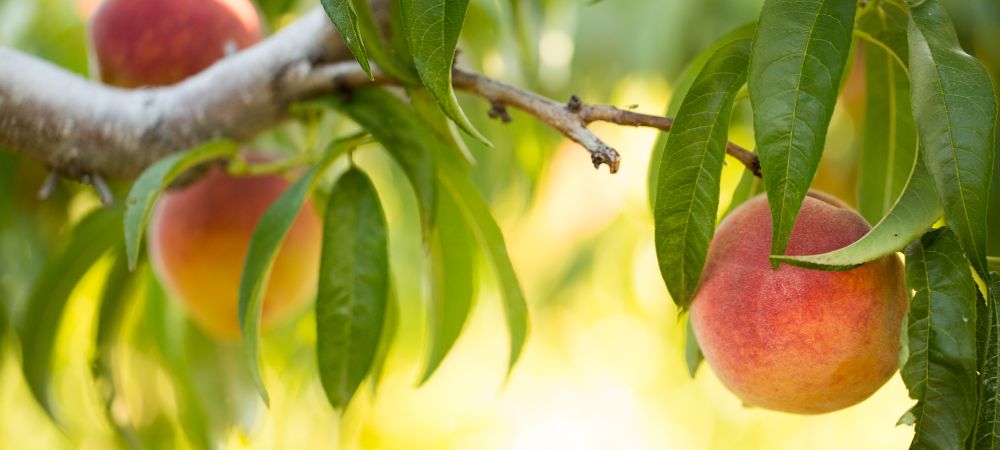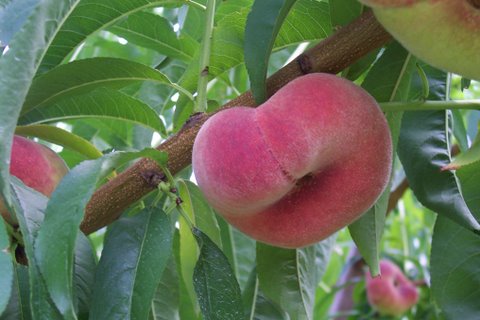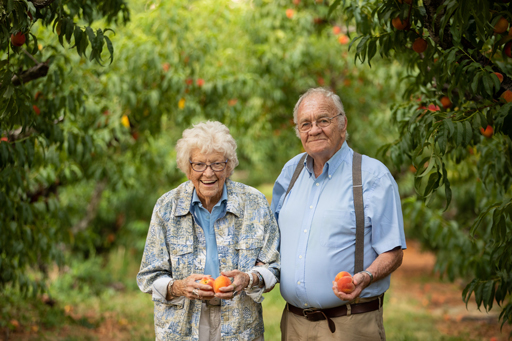We grow MANY different subtle varieties, most with boring technical names, so our peaches are best categorized as white, yellow, and donut. All our peaches are offered ready-picked, or as pick-your-own when in season at Chiles Peach Orchard and Carter Mountain Orchard.

{{ selectedOrchard }} Phone: {{ selectedOrchardPhone }}
Name Flavor Profile Good For {{ fruit.title }} {{ fruit.description }}N/A It looks like no fruit match that filter.
Try selecting a different orchard or fruit type.
Peach Picking Tips
- When selecting peaches, smell the fruit. The peach is a member of the rose family and should have a pleasingly sweet fragrance.
- Look for a creamy gold to yellow under color. The red or “blush” of a peach is an indication of variety, not ripeness.
- Peaches should be soft to the touch but not mushy. Don’t squeeze peaches; they bruise easily.
How to Store and Freeze Peaches
Place firm peaches on the counter at room temperature and they will soften within a few days. Promptly refrigerate ripe peaches and eat them within a week of purchase.
To freeze fresh peaches to enjoy later:
- Select peaches that are ripe, they should be soft but not mushy.
- Wash peaches thoroughly in cold water. Ice water is preferable for keeping the fruit firm.
- Peel and slice a small amount at a time, sprinkling a mix of 1 cup of sugar and 1 teaspoon ascorbic acid over the slices. Ascorbic acid is available at grocery and drug stores; it is not harmful and will not affect the taste of the fruit.
- Pack in airtight containers suitable for freezing up to 3/4 full, then freeze.
Tips for Cooking with Peaches
- To peel a peach: dip it into boiling water for 30 seconds, then in cold water. The peel should slide off easily.
- To keep sliced peaches from darkening: add lemon juice or ascorbic acid.
Nutritional Information
Serving Size……………..1 peach
Calories……………………40
Carbohydrates…………..10g
Protein……………………0.6g
Fat………………………..0
Fiber, dietary……………1.5g
Cholesterol………………0mg
Sodium…………………..0mg
Vitamin A……………….47RE
Peaches contain many important nutrients including: vitamin A, in the form of beta-carotene, which has been linked to a reduced risk of some forms of cancer; and riboflavin which is good for the eyes. They are an excellent source of fiber, and peaches are one of the lowest-calorie fruits, with virtually no fats.
Conversion Tips
One pound of peaches
= 3 medium peaches
= 2 cups sliced peaches
= 1 ½ cups peach puree
2 medium to large peaches
= 1 cup sliced peaches
Approx. 4 medium peaches
= 1 cup peach puree
1 bushel
= 18 to 24 quarts canned
= 32 to 48 pints frozen
2 to 2.5 lbs.
= 2 pints frozen
Should I cook with white or yellow peaches?
Use either for cooking, canning, or freezing, it’s just a difference in flavor! White-fleshed peaches are very sweet—like honey or sugar—and more mellow and smooth than the more traditional acidic taste of yellow-fleshed peaches.
What’s the best way to enjoy donut peaches?
Donut peaches are flat and either white or yellow-fleshed. They have a thin skin, a tiny pit, and are super sweet.
Donut peaches are perfectly sized for snacking and are Henry’s favorite!

What’s the difference between clingstone and freestone peaches?
Many people like to use clingstone peaches for pickling. For canning and freezing, most people prefer freestone fruit, as it is much easier to work with.
Generally, the early ripening varieties are clingstone. By late July and into August, all the varieties will be freestone.
- Clingstone: fruit does not come away from the seed easily
- Semi-clingstone: some of the fruit will come away
- Freestone: fruit easily breaks away from the seed
What are some good peach snacks?
Fresh-from-the-orchard peaches are “so dang good, you don’t need to do anything to them!”.
Cynthia Chiles, a 4th generation farmer, loves snacking on still warm from the sun peaches with the skin on.

Here are some other fresh ideas for enjoying one of nature’s sweetest fruits:
- Peach halves topped with fresh berries make an easy, yet elegant fruit salad.
- For a quick low-fat lunch, mix peach slices with low-fat yogurt or cottage cheese.
- Grilling fresh peach halves with blueberries and brown sugar is a delicious dessert for a picnic or barbecue. To prevent sticking when grilling peaches, brush the flesh with butter, olive oil, coconut oil, or the health oil of your choice.
- Blend peaches into frozen daiquiris, smoothies or shakes to cool down hot summer nights.
- Top low-fat vanilla frozen yogurt or a slice of angel food cake with fresh peaches for a healthy dessert.
- Bake them into summer´s favorite fruity desserts: cobblers, shortcakes and pies.
- Add fresh peaches to vanilla ice cream to create one of America´s all-time favorite ice cream flavors.
- Add peaches to spinach or pasta salads.
- Garnish desserts, main dishes and summer beverages with peach slices.

A Chiles Family Legacy
Generations of Chiles family members have grown up among the peach trees.
Cynthia Chiles remembers helping out in the packing house as a young girl, pulling rotten peaches from the bin. Her favorite part of peach season? “The peach blooms in the spring. There’s nothing more beautiful than those peach blossoms.”
Pictured: Ruth & Henry Chiles, 3rd generation farmers
For more Chiles family peaches history and stories, read “Sweet Peaches! The Chiles Family Shares Their 100+ Year Legacy” from Charlottesville Wine & Country Living.
